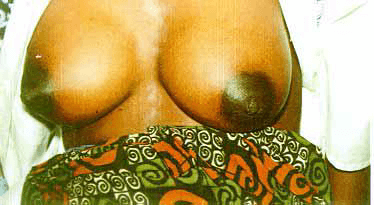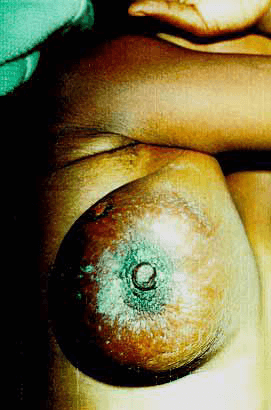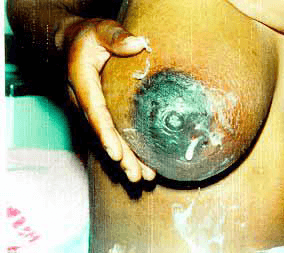Full Breasts
- Symptoms
- Breasts may feel hot, heavy, hard, or as if they are full of stones.
- There is NO FEVER.
- In most cases milk continues to flow, and infant can feed normally.
- Causes
- Late initiation of breastfeeding.
- Plenty of milk.
- Poor attachment.
- Infrequent removal of milk.
- Restricted length of feeds.

Engorged Breasts
- Breasts are over-full, partly with milk and partly with increased tissue fluid and blood that interfere with the flow of milk.
Symptoms:
Both breasts are involved.
- Breasts are painful.
- Breasts look tight and shining because of oedema in the tissue.
- Milk may stop flowing.
- Mother has a fever ("milk fever") for 24 hours, probably caused by substances from the milk passing into her blood. The fever stops without treatment. If it continues more than 48 hours, look for infection.
How engorgement leads to breastfeeding failure:
- Areola is tight, and it is difficult for infant to stretch the breast out for a test.
- Infant suckles in poor position and attachment that can damage the nipple skin and may cause a fissure.
- Mother feeds the infant less because of pain.
- Inhibitor takes over, and milk supply decreases.
- Breast may become infected.
Causes:
- Late initiation.
- Plenty of milk.
- Poor attachment.
- Infrequent removal of milk.
- Restricted length of feeds.
Table - 8. 2: - Table Showing the Difference Between Full and Engorged Breast
| Full breast |
Engorged breast |
| Hot |
Painful |
| Heavy |
Edematous |
| Hard |
Tight, especially nipple Shiny, may look red |
| Milk flowing |
No milk flowing |
| No fever |
Fever for 24 hours. |
Management of breast engorgement:
- The best management is prevention.
- Start breastfeeding soon after birth.
- Ensure good attachment and positioning.
- Practice unrestricted breastfeeding.
- Express breast milk to relieve discomfort.
- Do not wear tight brassieres.
- Take a warm shower.
- Hold a cold compress on the breast.
- Massage neck and back and lightly massage the breast.
- Try to relax.
Sore Nipples
It is a condition in which the nipple of the breast becomes wounded.
- Symptoms:
- Pain when the infant starts to feed or throughout the feeding.
- Reddened skin, sometimes with small blood spots.
- Causes:
- Pressure applied to the same point at every feed.
- Washing of nipples with soap.
- Use of sensitive creams.
- Nipples wet all the time.
- Improper attachment of infant.
- Management:
- Change feeding position at each feeding or even during a feeding.
- Ensure the infant is properly latched on.
- Keep nipples dry (no creams, no washing before and after feeding).
Cracked and Bleeding Nipples
In this case the nipple become fissured and the skin covering it will become opened.
- Symptoms:
- Opening in the skin that may bleed
- Causes:
- Prolonged soreness of the nipple
- "Barracuda" infants who vigorously and promptly grasp nipple and areola energetically for 10 to 20 minutes
- Poor attachment forming
- Management
- Examine breast, nipple, and nursing scene.
- Check for Candida.
- Build mother's confidence.
- Improve attachment.
- Express mother's milk and apply on the cracked nipple and areola and allow drying.
- Apply dry heat for 2 minutes after feeding.
- Refer for further examination and treatment.
Later Post-Partum Conditions: Blocked Ducts, Mastitis, Breast Abscess, Candidiasis or Thrush.
Blocked ducts: - This is a condition in which, the blockage of milk transporting tubes due to different causes such as breast engorgement leading to milk stasis.
- Symptoms: -
- Noticeable tender lump in the breast or areola that looks red and feels sore.
The condition will lead to

- Causes:
- Milk stasis as a result of infrequent, skipped, or delayed breastfeeding
- Poor drainage of an area of the breast (breastmilk not emptied)
- Local pressure on the breast from a tight brassiere
- Plugged or blocked ducts from engorgement
- Management:
- Check for tight clothes, maternal stress, or fatigue.
- Prevent engorgement or manage early.
- Offer the affected breast first to ensure really strong sucking.
- Gently massage lump toward the nipple with hot/cold compress.
- DO NOT STOP BREASTFEEDING
- Alternate sleeping positions using a pillow to relieve pressure.
- If no improvement, refer the mother to the health centre or hospital.
Mastitis
- An inflammation of the breast tissue, not the milk
- Abrupt weaning or temporary interruption of breastfeeding may slow healing or lead to further complications.
Symptoms:
- Inflammation of breast tissue surrounding the milk ducts.
- Tender, reddened area of the breast.
- Fever, chills, headache, fatigue and generalised body pains (flu-like symptoms).
- If untreated, can progress in to breast abscess.

Figure 8. 2. Figure showing an inflamed breast (mastitis).
C - Compresses
A - Antibiotics
S - Stress identification and management
S - Support and follow up
E - Effective and frequent removal of breastmilk
R - Rest
R - Referral
Breast Abscess

Figure 8. 3. Picture showing breast abscess. One can see the pus oozing from the areolar area.
- Causes:
- Improperly treated mastitis.
- Management:
- Warm packs.
- Complete removal of milk every 2 - 4 hours.
- Rest.
- Immediate referral to the Hospital.



